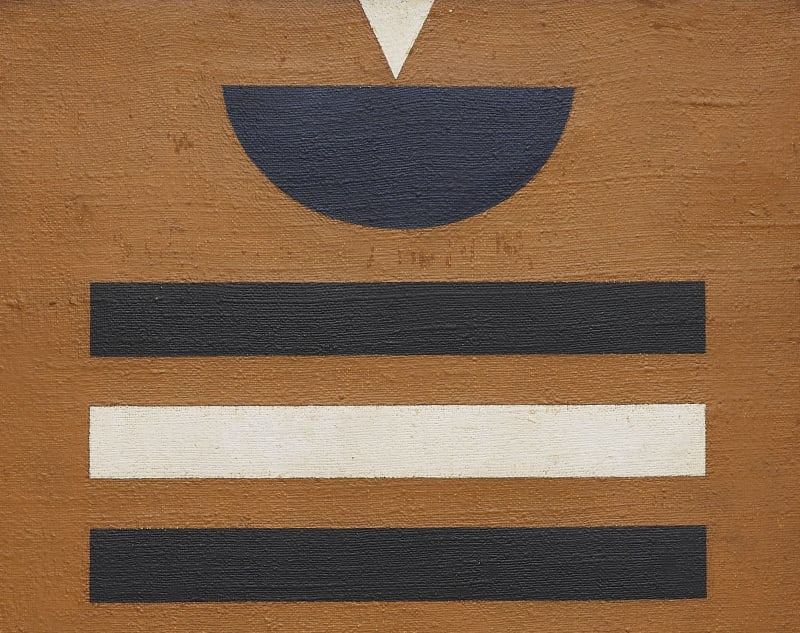Crossroads: Rubem Valentim’s 1960s : Curadoria: Gean Moreno | Institute of Contemporary Art – Miami
ICA Miami presents the first US museum exhibition of the late Afro-Brazilian painter Rubem Valentim (b. 1922, Salvador, Brazil; d. 1991, São Paulo). A singular voice in modernist painting and geometric abstraction, Valentim explored the medium’s formal concerns and social resonances across cultures and spiritual practices. This exhibition focuses on works Valentim produced in the 1960s, and the transformation of his work and thinking during this time.
Valentim split the decade between Brazil, which was then poised between rapid industrialization and military dictatorship, and Europe, where he first came upon the African art and Third World politics that would influence his painting practice. Having moved from his native Salvador, Bahia, to Rio at the end of the previous decade, in the 1960s, Valentim produced crisp paintings, characterized by rational form and symmetrical composition. Like the most progressive artworks produced in Brazil at the time, such as the paintings of Waldemar Cordeiro and the photographic experiments of Geraldo de Barros, Valentim’s paintings of this period are characterized by compositional clarity and easy communicability, and concerned with offering tools to a quickly urbanizing population to better function with new systems and velocities of communication, new technologies, and new ways of living in modernizing––if still quite segregated and economically uneven––cities.
From 1963 to 1966, Valentim lived in Europe. Although he settled for most of this time in Rome, where he held his first exhibition outside Brazil, he also visited other cities. In London, he saw African sculptures for the first time in person. The impact of this encounter is registered in the paintings of this period: works that retain the sharp lines and shallow pictorial spaces of geometric abstraction, but in which generic forms become shapes that allude to totems, objects used in worship ceremonies, fragments of temple architecture, and to signs, such as axes and arrows, associated with Afro-Brazilian deities. Valentim’s sojourn abroad culminated with his participation in the First World Festival of Negro Arts held in Dakar, Senegal, in 1966.
In 1967, upon returning to live in Brasilia, the country’s new modern capital, Valentim began a radical series of works titled “Emblems.” Produced in shallow bas-relief, these works extend into the physical space of the viewer, rejecting any remaining illusionistic possibility that the picture plane offers. They also further reduce Valntim’s palette, often employing only a single color over a pristine white background. While still using abstracted geometric forms, Valentim searched to deepen his connection to the art of Afro-Brazilian religious practice, and create paintings as a technology to interpret cosmological meaning. In the process of embodying this new task, the paintings grow increasingly ideographic, whereby sign and meaning fuse and representation itself is troubled.
Valentim’s work can be found in the collections of the Museum of Modern Art, New York; Museum of Fine Arts, Boston; Pinacoteca do Estado de São Paulo; Museu de Arte Moderna do Rio de Janeiro; Museu de Arte Moderna da Bahia; Museu de Arte de Brasília; Museu de Arte de São Paulo (MASP); Museu Afro Brasil, São Paulo; and the Museum of Fine Arts, Houston. His work has been exhibited at the Venice Biennale and the São Paulo Biennial. In 2019, he was the subject of a major retrospective exhibition, “ Rubem Valentim: Afro-Atlantic Constructions,” at MASP.
“Crossroads: Rubem Valentim’s 1960s” is organized by ICA Miami and curated by Gean Moreno, Director of the Art + Research Center at ICA Miami.

![Rubem Valentim, Sem título [Untitled], 1960](https://artlogic-res.cloudinary.com/w_1600,h_1600,c_limit,f_auto,fl_lossy,q_auto/artlogicstorage/antoniabergamin/images/view/c1c4dc281ceca9b7e606832e7fdc8a59j/galatea-rubem-valentim-sem-t-tulo-untitled-1960.jpg)

